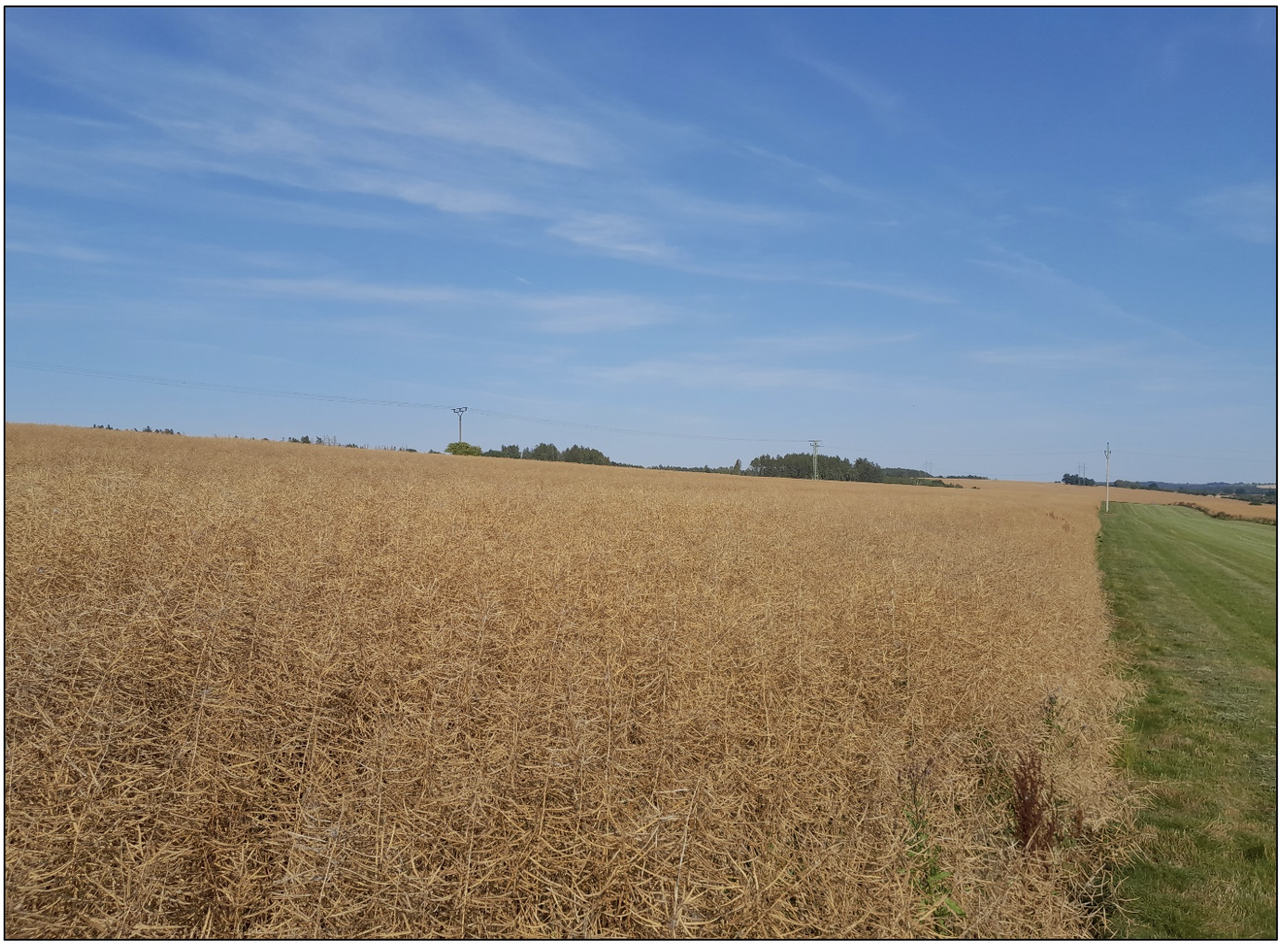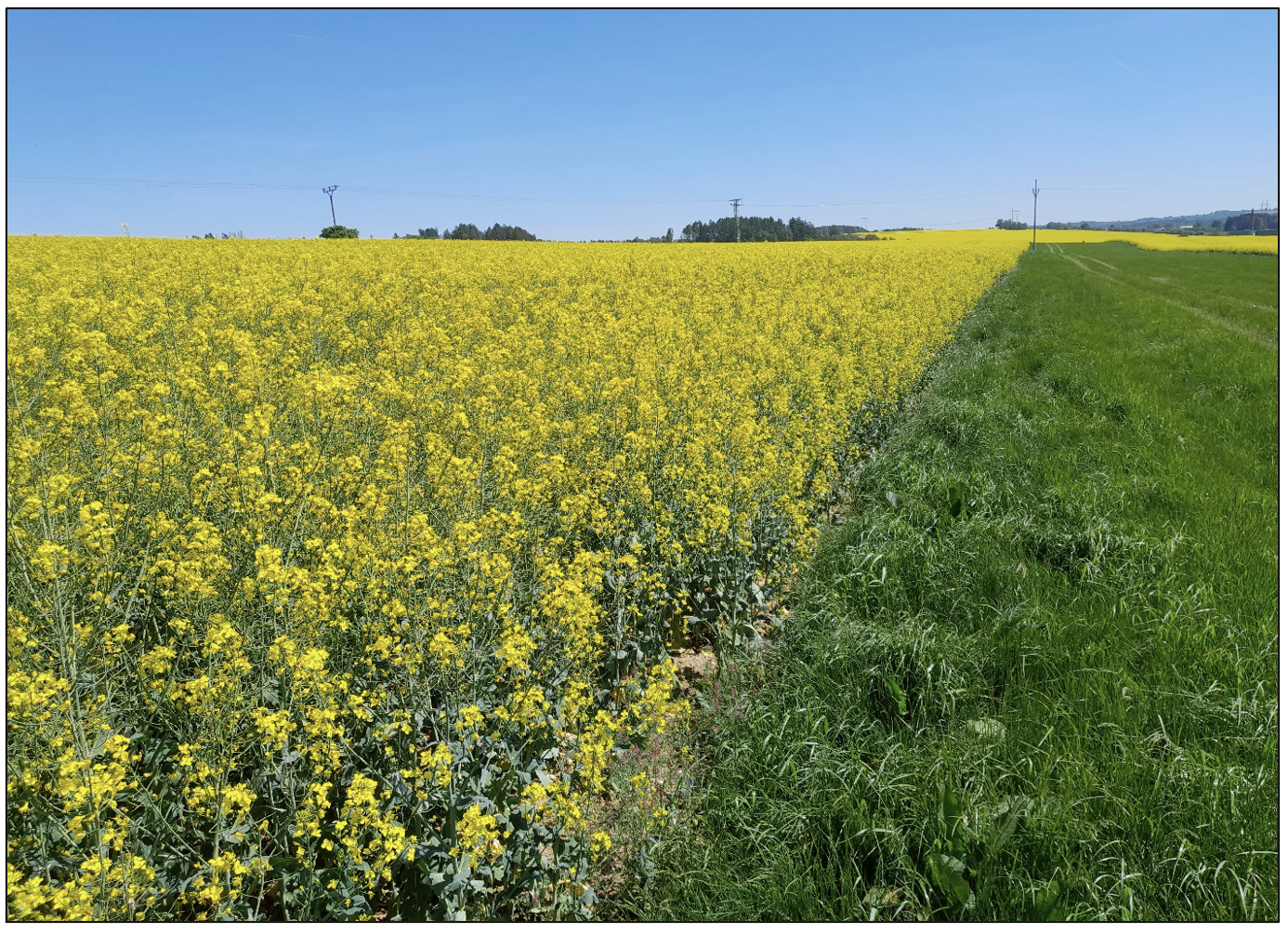
Report on results observed in the operational experiment from 2022
evaluating the effect of soil treated with soil adjuvant (PPL) in the form of concentrated biological Azoter SC fertilizer (including fungal biocontrol agent Coniothyrum minitans) with a separate F additive (soil fungus Trichoderma atroviride) in the cultivation technology of winter oilseed rape
* * *
Ing. Tomáš Javor, DiS., Ing. Lenka Beranová, DiS. a kol., AGROEKO Žamberk spol. s r.o.
Josef Hamsa a kol., ZOD Habry
Jiří Řezníček, AZOTER CZ s.r.o.
Characteristics of the experiment: Verification of Azoter SC+F biological fertilizer in a dose of 10 l/ha (and additive F in a dose of 0.1 l/ha) was applied to agrochemical deficient soils of the Bohemian-Moravian Highlands (mainly of soil pH and phosphorus availability), in cadastral territory of Habry (Havlíčkův Brod district). On the experimental plot, there was a representative medium-heavy to lighter soil texture with a slight to moderate admixture of soil skeleton. They are mesobasic cambium soils, with a slightly acid pH on gneisses and other solid rocks. The area is in a mildly warm and humid climate region. The average altitude of the plot was 489 m. Spring barley was the pre-crop for rape. The pre-crop straw was removed from the plot. Before plowing, digestate from the biogas station was applied in a dose of 18 t/ha (about 60 kg N/ha). The soil on the experimental plot before the experiment was established i.e., before the application of the tested biological fertilizer (tab. 1), showed an acidic soil reaction (pH), a low content of available phosphorus (P), a satisfactory content of potassium (K), calcium (Ca) and magnesium (Mg) (tab.1).
| pH/CaCl2 | P | K | Ca | Mg |
| mg/kg of soil | ||||
| 5,10 | 68 | 168 | 1493 | 143 |
| Acidic | Low | Satisfactory | Satisfactory | Satisfactory |
Tab. 1. Agrochemical properties of the soil on the plot before the application of fertilizers and tested Azoter SC + F biological product (Habry, 18. 7. 2021)
Azoter SC biological fertilizer (containing non-symbiotic diazotrophic bacteria binding atmospheric nitrogen: Azotobacter chroococcum, Azospirillum brasilense, bacteria involved in making phosphorus available in the soil: Bacillus megaterium and sclerotia plant pathogenic fungus Sclerotinia spp. fungus Coniothyrium minitans) was applied using a ground sprayer just before preparing the soil for sowing on 29 August 2021 in a dose of 10 l/ha together with the addition of F preparation in a dose of 0.1 l/ha. The dose of the spray was 300 l/ha. The addition of F component contains Trichoderma atroviride parasitic fungus, which limits the development of fungal spores of the genus Fusarium (it also limits Pythium, Rhizoctonia and Botrytis) and strengthens the effect of the fertilizer in the conversion of hemicelluloses and cellulose contained in post-harvest residues.
The fertilizer was applied using the ground sprayer at a dose of 250 l/ha. The incorporation of the applied product was carried out by heavy harrows and subsequently by rotary harrows in combination of seed drills (seeding machine).
Results of the applied Azoter SC + F biological fertilizer to the soil before the establishment of the winter rape crop
1) The effect of Azoter SC + F biological fertilizer on the content of organic matter and other agrochemical properties of the soil
In the spring, during the regeneration of the established winter rape stands, the soil on the control variant that was not treated with the tested product, showed a high content of organic matter (Cox.). Before the harvest of the control stand, the content of organic matter (by 7%) in the soil continued to increase. After the carbon fixation by plants and the release of carbonaceous compounds into the soil by root exudation, the content of Cox in soils increased from 2.59% to 2.78%, i.e., by less than 0.2%. After the soil was treated with the tested Azoter SC + F product, a high content of organic matter was detected in the spring, too. With the onset of the main life activity of purposefully applied bacteria and fungi in the soil, the organic matter content decreased by less than 7%. The consumption of organic matter as an energy source for applied and native soil microbes was less than 0.2% of Cox soil content. Temporary soil enrichment with organic matter at the time of crop harvest did not occur after the soil was treated with the tested biological product. However, the content of organic matter in the soil after the treatment with the tested fertilizer remained in the high content category, i.e., the same as in the slightly enriched control plot with cultivated vegetation. Therefore, there is a certain but very small consumption of carbonaceous organic substances as a source of energy for the applied and potentially supported naturally occurring microorganisms in the soil.
The content of total nitrogen (Ntot) and the prevailing organic proportion of nitrogen (Norg) significantly decreased in the control variant that was not treated with the biological fertilizer between the period of spring regeneration and the harvest of the stands. On the control variant, a decrease of Norg content in the soil was more than 20%. On the variant treated with the tested fertilizer, there was a minimal decrease of Norg content, only by less than 1.5% between the period of the stand regeneration and the harvest. It is evident that the stable (stock) nitrogen content (Norg) in the soil decreased only minimally after the treatment with the biological Azoter SC + F preparation. Apparently, the micro-organisms applied to the soil with the fertilizer used very little nitrogenous organic compounds as a source of energy in the spring.
On the control plot, the content of mineral forms of nitrogen (N-NH4+ and N-NO3-) in the soil was very comparable to the soil treated with the tested product and does not indicate a higher mineralization of organic nitrogenous compounds due to the targeted application of microbes. Compared to the control plot, a slightly higher content of the organic fraction (Norg) of nitrogen in the soil was also found in the period of winter rape harvest after the treatment with the tested fertilizer. This also pointed to the conversion of plants´ unused bound atmospheric nitrogen (N2) by purposefully supplied diazotrophic bacteria, most probably due to ongoing biological immobilization in the soil. The content of potentially releasable nitrogen (Norg) from the soil supply for the another subsequent crop was slightly increased (by 5%).
The rate of carbon and nitrogen content (C : N) in the soil after its treatment with the tested biological Azoter SC + F preparation did not change between the period of spring regeneration and winter rape harvest. The ratio of C:N remained wide and indicated a lower release of nitrogen from organic matter, i.e., for a slower and less efficient nitrogen mineralization activity in the soil. On the control variant without the soil treatment with the tested biological product, an increase in the C:N ratio was indicated during the spring vegetation. However, the C:N ratio was still relatively wide even in spring, and the soil did not show conditions for rapid mineralization activity of nitrogenous compounds during rapeseed vegetation.
The soil pH during the spring vegetation of winter rape showed a constant state with minimal differences in both on the control plot and the on the variant treated with the tested biological product. However, it was found that there was an increase in soil pH during the autumn. The increase was higher after the application of the biological fertilizer. From the original value of soil pH = 5.1 analyzed before sowing the winter rape, there was an increase in pH by 0.6 after the soil was treated with the tested Azoter SC + F product. On the soil that was not treated with the tested product, the increase in pH was smaller – only by 0.3.
During the spring vegetation of winter rape there was an increase in the content of available phosphorus (P) in the soil by 30% on the untreated control variant. On the other hand, after treating the soil with the tested fertilizer, the phosphorus content decreased by 17%. However, the application of the tested preparation boosted the content of accessible phosphorus in the soil already during autumn. The original phosphorus content before sowing the winter rape was 68 mg/kg. After treating the soil with the tested product, this content almost remained the same until the spring. During the intensive plant growth, it dropped to 55 mg/kg of soil. On the control variant without treatment with the tested product, a lower content of accessible phosphorus was found in the spring (43 mg/kg). The low phosphorus content at this time caused greater phosphorus deficit in plant nutrition during spring intensive growth. However, the content of available phosphorus in the soil in the control variant and after the treatment with the tested product was slightly different for the various sampling of the stand element before harvest (with an effect for the subsequent crop).
The content of available potassium (K) in the soil was almost the same during the spring vegetation of winter rape in both the control variant and the variant treated with the tested product. However, an almost 8% higher supply of soil with available potassium was found after treating the soil with the tested preparation in the spring and it persisted until harvest. Thus, it´s evident that there is a certain effect of the biological preparation on making potassium available in the soil during autumn (lasting until spring).
On the control variant that was not treated with the fertilizer, the content of available calcium (Ca) in the soil showed a 6% decrease in the spring vegetation of winter rape. From the former content of available calcium in the soil before sowing (1493 mg/kg), the content of calcium increased by almost 4% after treating the soil with the tested preparation. This increase occurred in the spring and continued until harvest.
The content of available magnesium (Mg) in the soil showed a significant decrease in the control variant during the spring vegetation of winter rape, compared to calcium, by almost 30%. After treating the soil before sowing the winter rape with the tested Azoter SC + F preparation, there was a slight decrease in magnesium content in the soil. The content of available magnesium before harvesting the winter rape was higher after the soil was treated with the tested product.The soil after the treatment with the biological preparation showed a better supply of nutrients for the subsequent crop, including a higher pH (table 2).
| Indicator | Control | Azoter SC + F | |||||
| 12.04.2022 | 20.07.2022 | Change | 12.04.2022 | 20.07.2022 | Change | ||
| Cox. (%) | 2,59 | 2,78 | 0,19 | 2,98 | 2,79 | -0,19 | |
| Ntot. (mg/kg) | 1986 | 1536 | -450 | 1703 | 1620 | -83 | |
| Norg. (mg/kg) | 1917 | 1525 | -392 | 1630 | 1608 | -22 | |
| N-NH4+ (mg/kg) | 38,7 | 2,11 | -36,59 | 40,2 | 3,01 | -37,19 | |
| N-NO3– (mg/kg) | 30,7 | 8,81 | -21,89 | 33 | 8,86 | -24,14 | |
| C : N (ratio) | 13,0 | 18,1 | 5,1 | 17,5 | 17,2 | -0,3 | |
| pH/CaCl2 | 5,10* | 5,39 | 5,44 | 0,05 | 5,69 | 5,72 | 0,03 |
| P (mg/kg) | 68* | 43 | 56 | 13 | 66 | 55 | -11 |
| K (mg/kg) | 168* | 247 | 245 | -2 | 267 | 263 | -4 |
| Ca (mg/kg) | 1493* | 1696 | 1591 | -105 | 1871 | 1944 | 73 |
| Mg (mg/kg) | 143* | 255 | 178 | -77 | 201 | 204 | 3 |
Tab. 2. Change in the content of organic matter (Cox), organic (Norg) and mineral nitrogen (N-NH4+ and N-NO3–), soil pH, available phosphorus, potassium, calcium, and magnesium in the soil under the winter rape stands after the tested Azoter SC + F product was applied (soil profile 0-30 cm)
Note: * initial value before starting the experiment (before application of the tested preparation)
2) The effect of Azoter SC+F biological fertilizer on the vegetative phase and nutritional status of plants
The vegetative phase of the plants at the beginning and end of the spring vegetation was better after the soil was treated with the tested biological preparation before sowing. The winter rape stands showed a slow regeneration capacity after winter period. However, on 12/04/2022 when the growth was getting longer, it was found that the plants regenerated faster in the soil treated with the tested preparation and the above-ground biomass increased. On the control variant without soil treatment with a biological preparation, the dry weight of the above-ground biomass at the beginning of the growth was 5.03 t/ha. The stand in the control variant mainly showed BBCH 31 – 33 growth stage (length of the main stem of the plants up to 15 cm). After treating the soil with the tested preparation, the plants showed a 13% higher above-ground biomass weight, i.e., 5.70 t/ha. The stand grown in the soil after the application of tested preparation showed BBCH 33 – 35 growth stage (length of the main stem of the plants up to 25 cm).
After the end of the intensive growth and after full bloom of the stands (on 19/5/2022), the supporting effects of the tested product on the growth of above-ground biomass were found. In the control variant that was not treated with a biological preparation, the stand showed a dry mass of aboveground biomass (13.22 t/ha). After treating the soil with the tested preparation before sowing, a 7% higher increase in the weight of the above-ground biomass was found, i.e., 14.20 t/ha. After the soil was treated with the tested product, plants were well branched, i.e., they showed a higher number of main branches on the stem (Pic. 1).
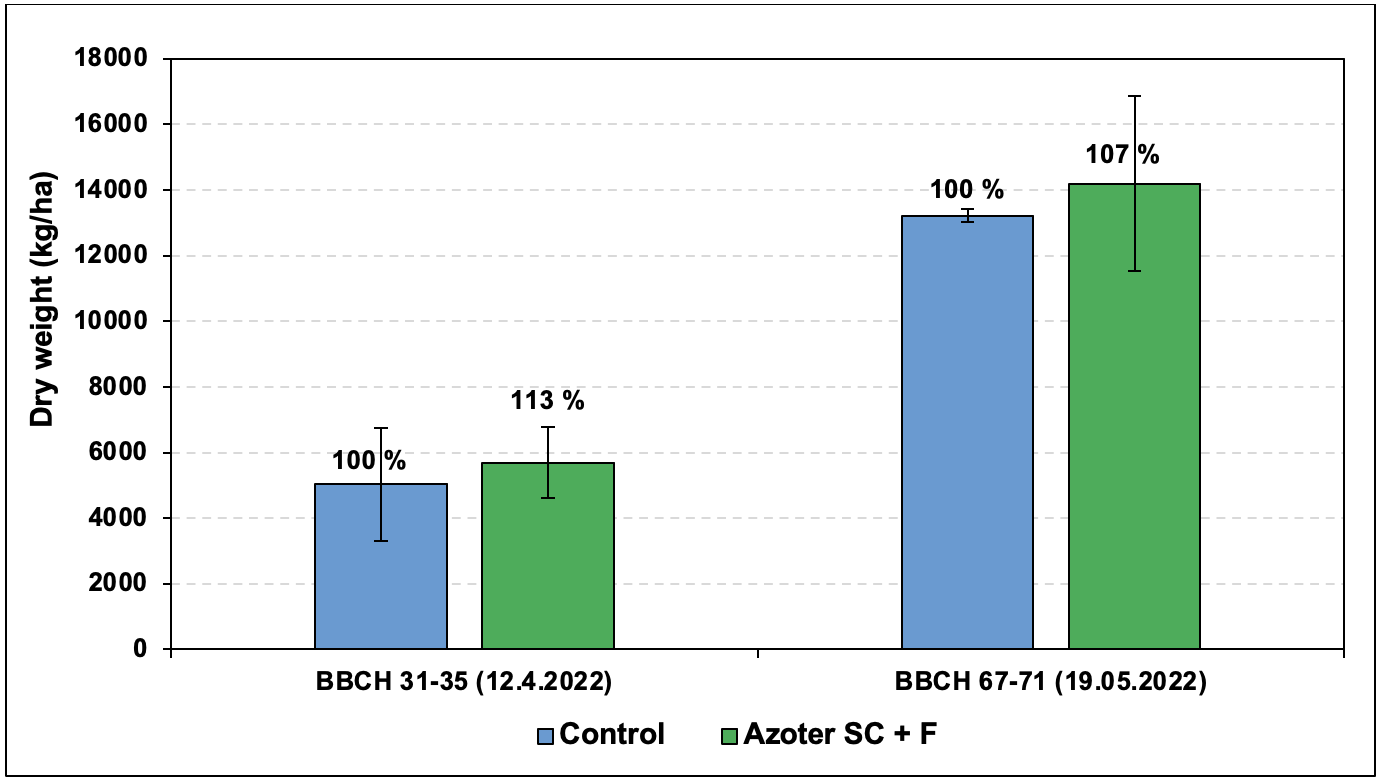
Pic. 1. Dynamics in dry weight increase of the above-ground biomass of winter rape in the soil without and with treatment with the tested fertilizer before sowing
Plant nutrition after the effect of nitrogen regenerative fertilization of stands (with sulfur) was slightly above the optimum (no deficit) in both the control stand and the stand variant treated with the tested preparation. Plant nutrition with nitrogen (N) at the beginning of long growth was slightly better (by 2%) after the soil was treated with biological Azoter SC+F preparation before sowing. Phosphorus (P) plant nutrition at the beginning of spring vegetation was by 4% better after the soil was treated with the tested preparation before sowing.
In both stands, plant nutrition with phosphorus was at the level of medium deficit. On the other hand, plant nutrition with potassium (K) was worse by 8% after the soil was treated with the tested preparation compared to the control variant. In the control variant, the stand had a moderate potassium deficiency. After treating the soil with the preparation, potassium deficiency of the stand was medium. Plant nutrition with calcium (Ca) was by 2% better after the soil before sowing was treated with the preparation. Both stands showed from slight to no calcium deficiency. In the control stand without soil treatment before sowing, plant nutrition with magnesium was significantly better (optimum excess). After the soil was treated with the tested preparation, the nutritional status of plants with magnesium (Mg) was by 17% worse, i.e., at the level of a slight deficiency.
It is evident that the improved availability of phosphorus in the soil after the application of the tested preparation before sowing showed better plant nutrition with phosphorus in the period of cold spring. Plant nutrition with nitrogen was better after treating the soil with the tested biological preparation. There was about 15 kg N/ha greater supply of available mineral nitrogen in the soil. The mobilization of potassium and other macronutrients was not proved in the spring nutrition of winter rape plants (Pic. 2).
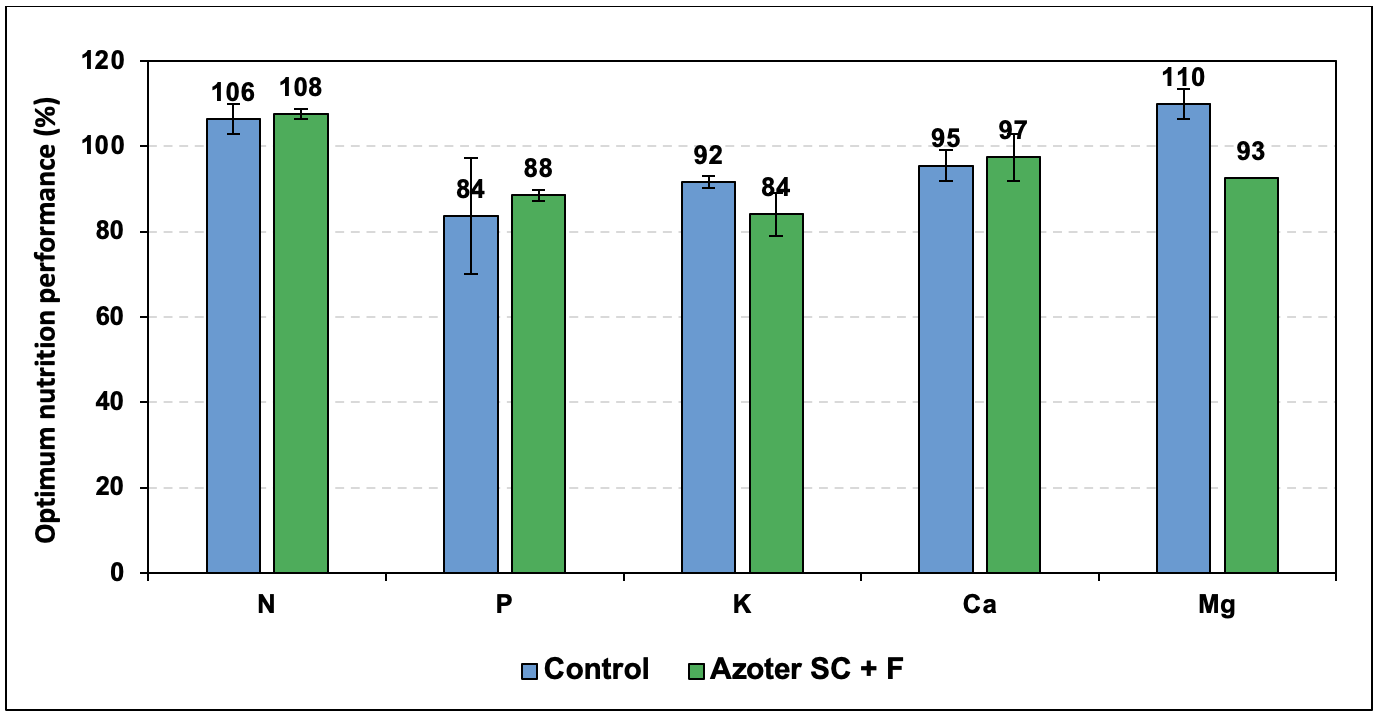
Pic. 2. Nutritional status of winter rape plants during the beginning of long growth in the soil without and with the pre-sowing treatment with the tested product (status as of 12/04/2022, BBCH 31 – 35)
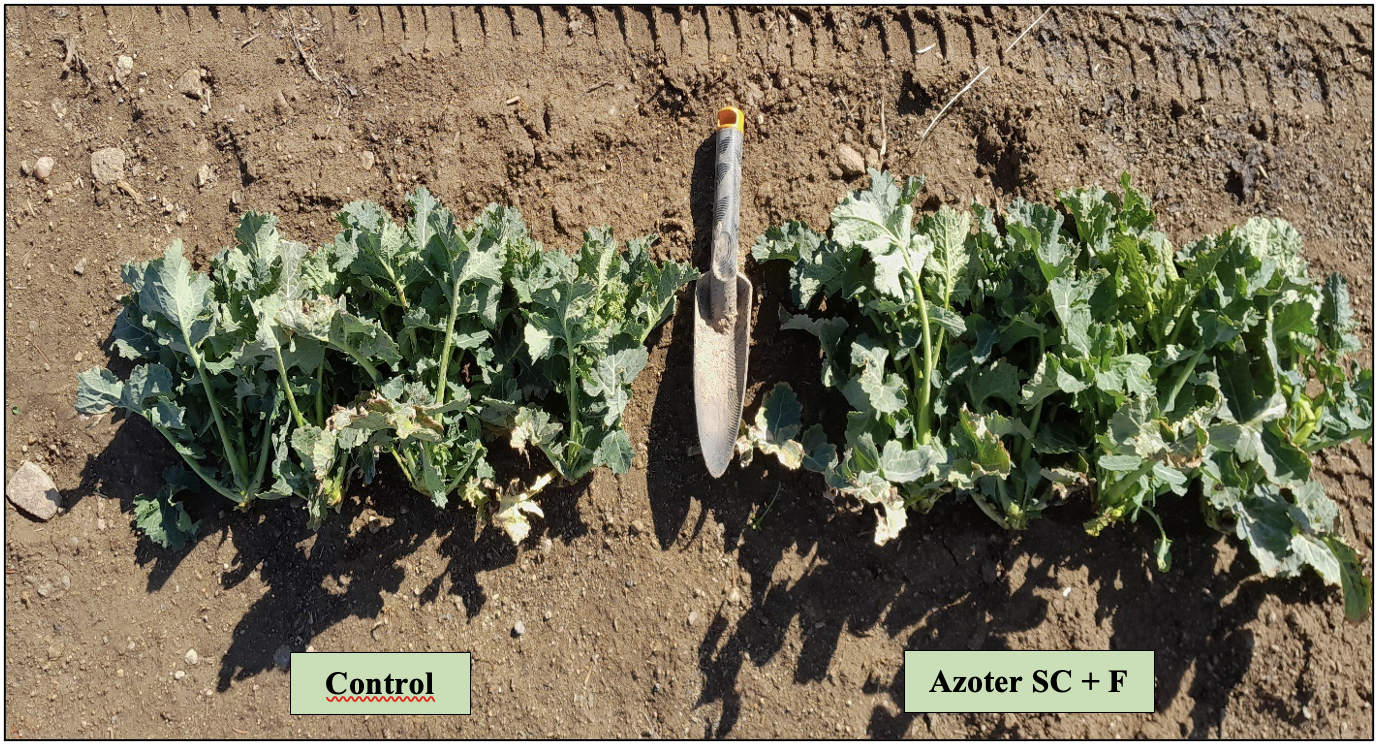
After intensive growth in the period when the stands finish flowering, the nutrition of plants with nitrogen (N) was in a deep deficit in the control variant without the tested biological fertilizer treatment. Plant nutrition with nitrogen was by 7% better after pre-sowing soil treatment and the stand was at the level of medium deficiency. Plant nutrition with phosphorus (P) was also at a level of deep deficiency in the control variant. After treating the soil with the tested preparation, plant nutrition with phosphorus applied after flowering was by 4% better. It was at a level of medium deficiency.
Plant nutrition with potassium (K) was comparable to the control variant and the soil after the biological fertilizer treatment (difference 1%). Both stands had the optimal level of potassium nutrition. Plant nutrition with calcium (Ca) was at the level of medium deficit in both stands. Plant nutrition was by 4% lower in the stand after the soil was treated with a biological fertilizer. Plant nutrition with magnesium even at the end of the growing season was significantly better (in the optimum level) in the control variant without treating the soil with a biological product. Plant nutrition with magnesium after treating the soil with the tested preparation was by 9% lower – at the level of mild deficiency.
It is evident that plant nutrition with calcium and magnesium was not improved after treating the soil with a biological fertilizer. In these components, the effect of the fertilizer persisted in mobilizing (making available) and increasing the supply of the soil for the subsequent crop. The direct effect of the tested preparation was confirmed in the second half of the growing season by the effect on better phosphorus nutrition of plants (mobilization of the component in the soil) and nitrogen nutrition (fixation of N2 and conversion of nitrogenous organic substances in the soil). In the second half of the vegetation of winter rape, a slight effect on the nutrient status of the plants with potassium is partially shown after the identified mobilization of potassium from the soil supply (Pic. 3).
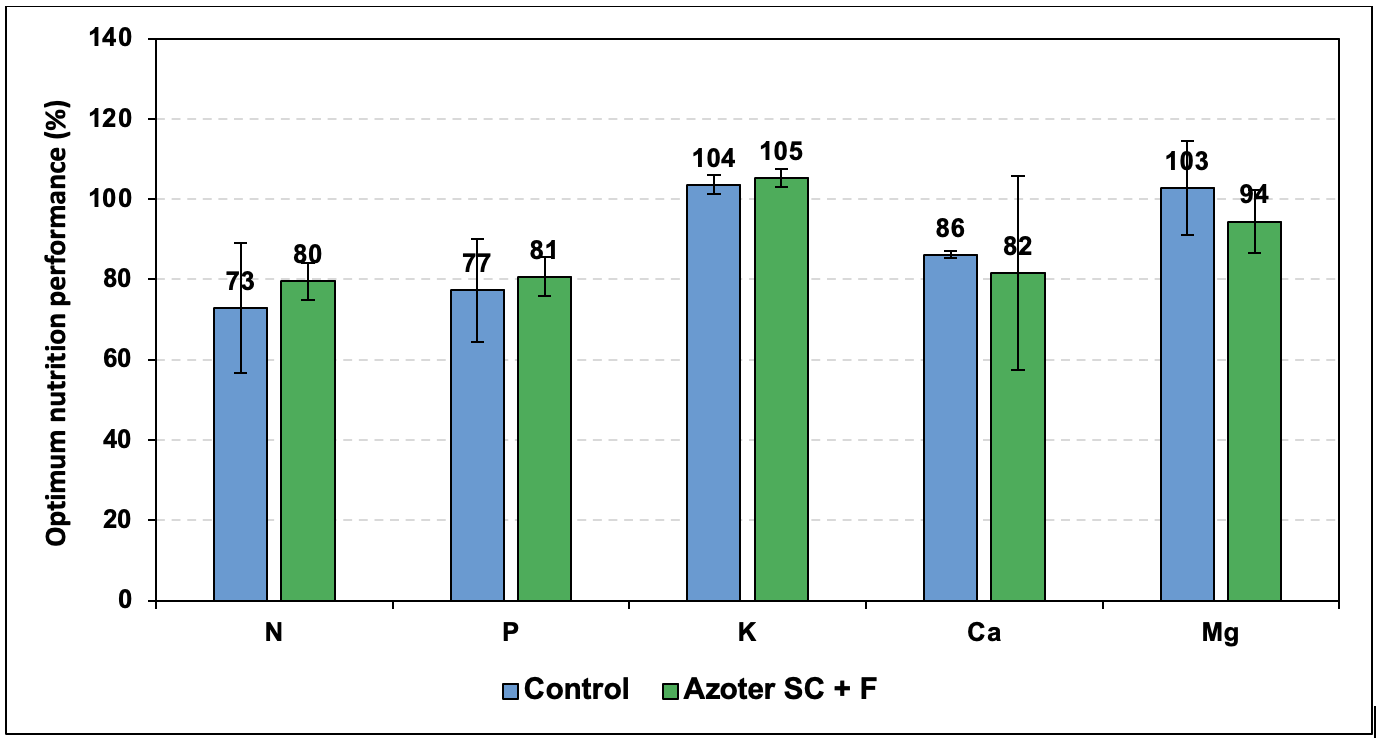
Pic. 3. Nutritional status of winter rape plants in the soil without and with the pre-sowing treatment with the tested product after flowering period (status as of 12/04/2022, BBCH 67 – 71)
3) The effect of Azoter SC + F biological preparation on the plant health
Before harvesting, a symptoms analysis of the fungal and rots attack of stalks was performed (main stems) caused by a complex of brassica fungal diseases, which commonly occur in the growing area and strongly reduce the yield. The plants mainly showed from moderate to severe attack of stems by rots. Pre-sowing soil treatment with the tested Azoter SC+F biological product containing a parasitic fungus that reduces phytopathogenic species that are harmful to brassicaceous, and other crops, contributed to repress the intensity of the attack, i.e., mainly to reduce the number of strongly attacked and completely dead stems. In experiment 1 (upper part), a significant increase (by 23%) in the number of symptom-free (healthy) plants was found after pre-sowing treatment with the tested product. The number of moderately attacked, still living plants was slightly different (6%) compared to the control variant and treated soil. The occurrence of strongly attacked and completely dead rape plants was significantly reduced (by 17%) after the soil was treated with the tested biological preparation containing selected parasitic fungi. This experiment was characterized by the location on a plateau with more intensive air flow from the north and northwest.
In experiment 2 (lower part), there were plants without any symptoms of attack by fungal diseases on the stems in a 4% higher proportion after treating the soil with the tested product. A significantly lower occurrence of moderately infested plants was recorded on the control stand. Here, the occurrence of such attacked plants was by 43% lower than after treating the soil with the tested preparation. However, in the control variant without soil treatment, a significantly higher occurrence of plants with advanced, strong attack and total plant death before harvest was found. After treating the soil with the tested biological product, the incidence of heavily infested plants decreased by 47%. The experiment was in a valley, on the plot with south-west to west exposure and less air flow (Pic. 4).
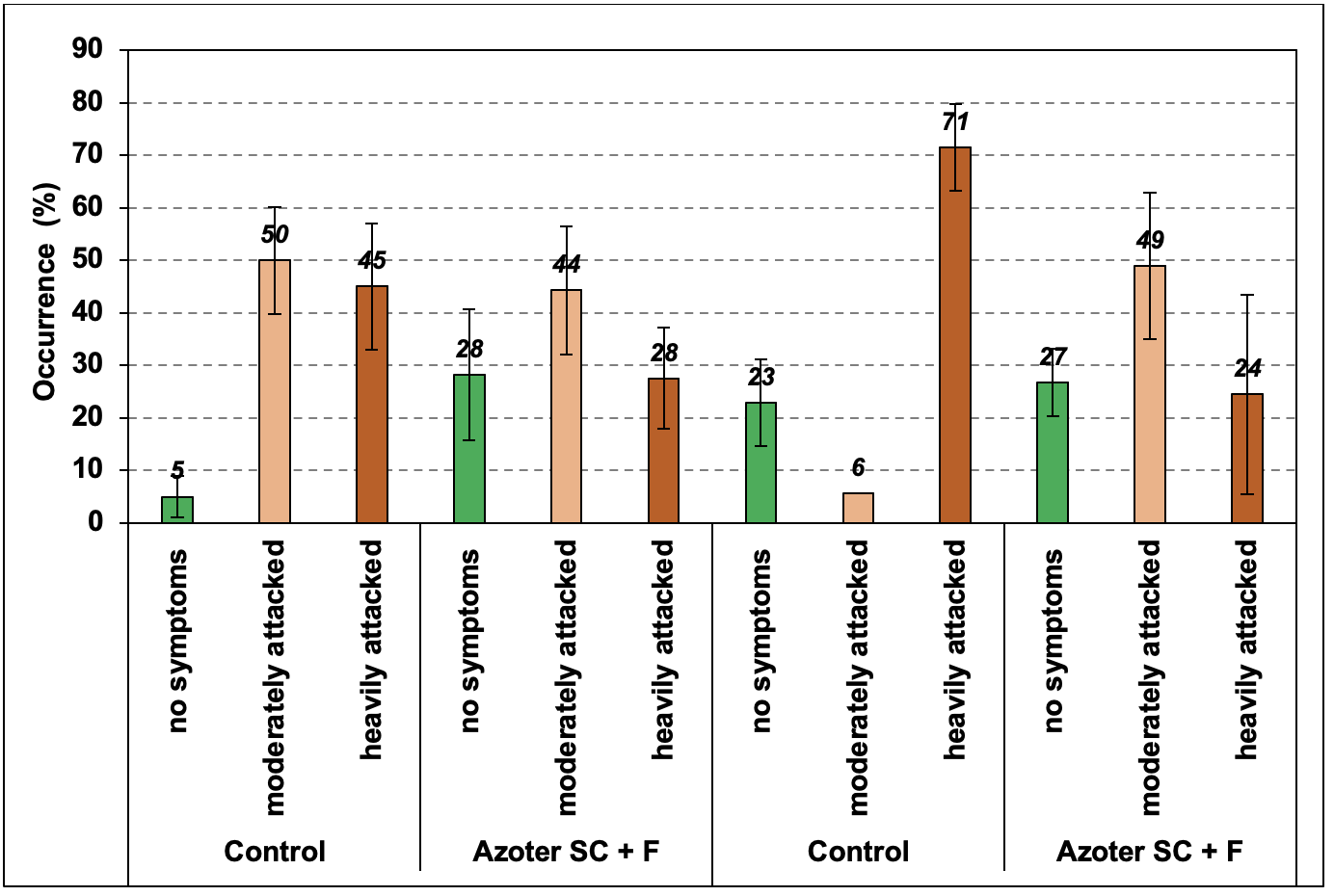
Pic.4. Occurrence of diseased plants of winter rape stands before harvest (proportion of occurrence of healthy, moderately, and heavily attacked stalks by the rot complex, status as of 20/07/2022)
| Experiment | Intensity | Occurrence (%) | ||||
| Control | Azoter SC + F | |||||
| Upper part (1) | No symptoms | 5 | a | 28 | b | |
| Moderately attacked | 50 | a | 44 | a | ||
| Heavily attacked | 45 | b | 28 | a | ||
| Lower part (2) | No symptoms | 23 | a | 27 | a | |
| Moderately attacked | 6 | a | 49 | b | ||
| Heavily attacked | 71 | b | 24 | a | ||
| Note: Values in the line marked with different letters show statistically provable differences at the level signifikance p <0,05 (ANOVA, Tukey test). | ||||||
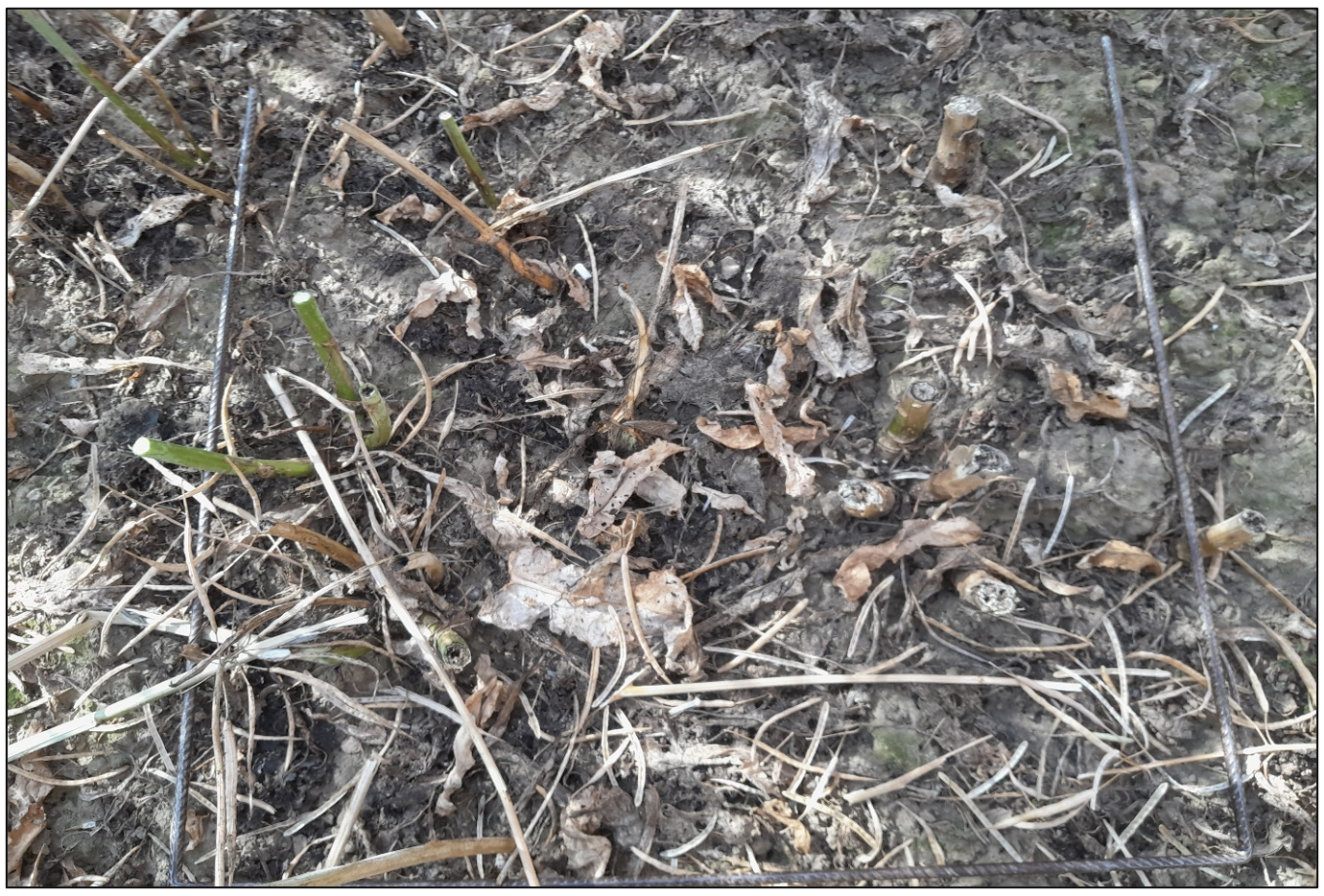
Before harvest, the plants in the soil without biological Azoter SC + F treatment showed a greater proportion of severe attack by the rot complex (Sclerotinia sclerotiorum – White mold, syn. Verticillium longisporum – verticillium wilt of plants; and others).
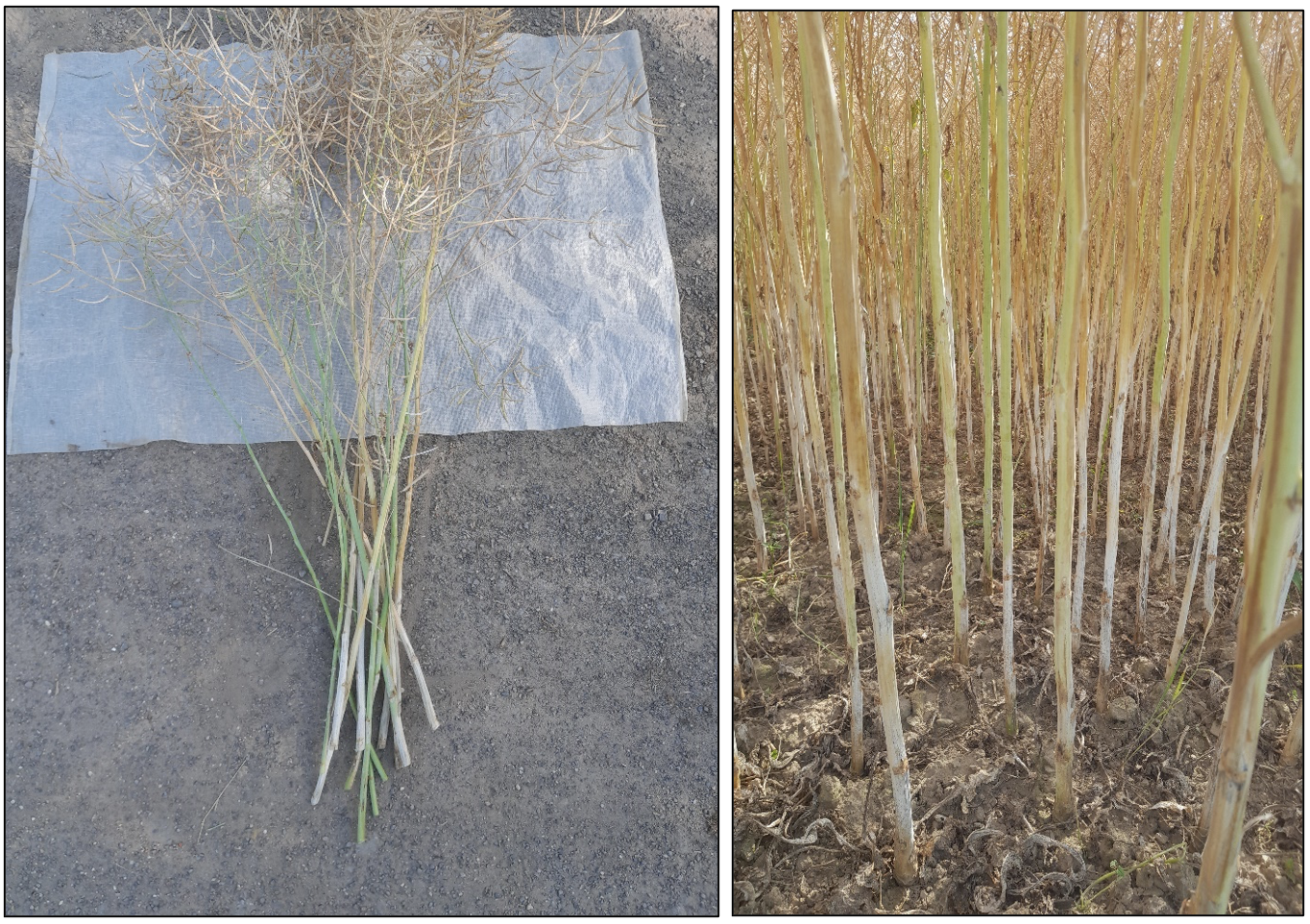
Healthy and variously attacked stands of rapeseed without biological Azoter SC + F treatment
4) Effect of the biological Azoter SC + F preparation on yield and seed quality
The stands were harvested with a conventional threshing machine, and then the harvested seed was weighed separately, and the content of moisture was measured. Winter rape stands after pre-sowing treatment with a tested biological preparation containing parasite strains of fungi against economically important phytopathogenic organisms, strains of bacteria fixing atmospheric nitrogen (N2) and strains promoting the conversion of organic substances and the release of nitrogen and phosphorus (and potassium) into the soil showed an average increase in yield seeds from 3.28 t to 4.22 t/ha, i.e., by 29%.
A smaller increase in yield was found in the experiment 1, where a control yield of 3.10 t/ha was achieved. The soil after the treatment with the tested biological product before sowing the crop provided an increase in seed yield to 3.45 t/ha, i.e., by 11%. After treating the soil with the preparation, a significantly smaller proportion of attacked plants by stem rot before harvest was found. The stand also showed better plant nutrition with phosphorus, nitrogen and partially with potassium.
A significant increase in seed yield was found in experiment 2. The stand on the untreated soil (control) achieved a yield of 3.46 t/ha. After pre-sowing soil treatment with the preparation, an increase in the seed yield by 44% was detected, i.e., to 4.99 t/ha. After the soil was treated with the tested product, the stand showed a significantly lower occurrence of heavily attacked, dead plants before harvest. At the same time, the stand showed better plant nutrition with phosphorus, nitrogen and slightly with potassium. The major effect of the tested product in this stand was in increasing the number of naturally growing plants up to the harvest period (Pic. 5).
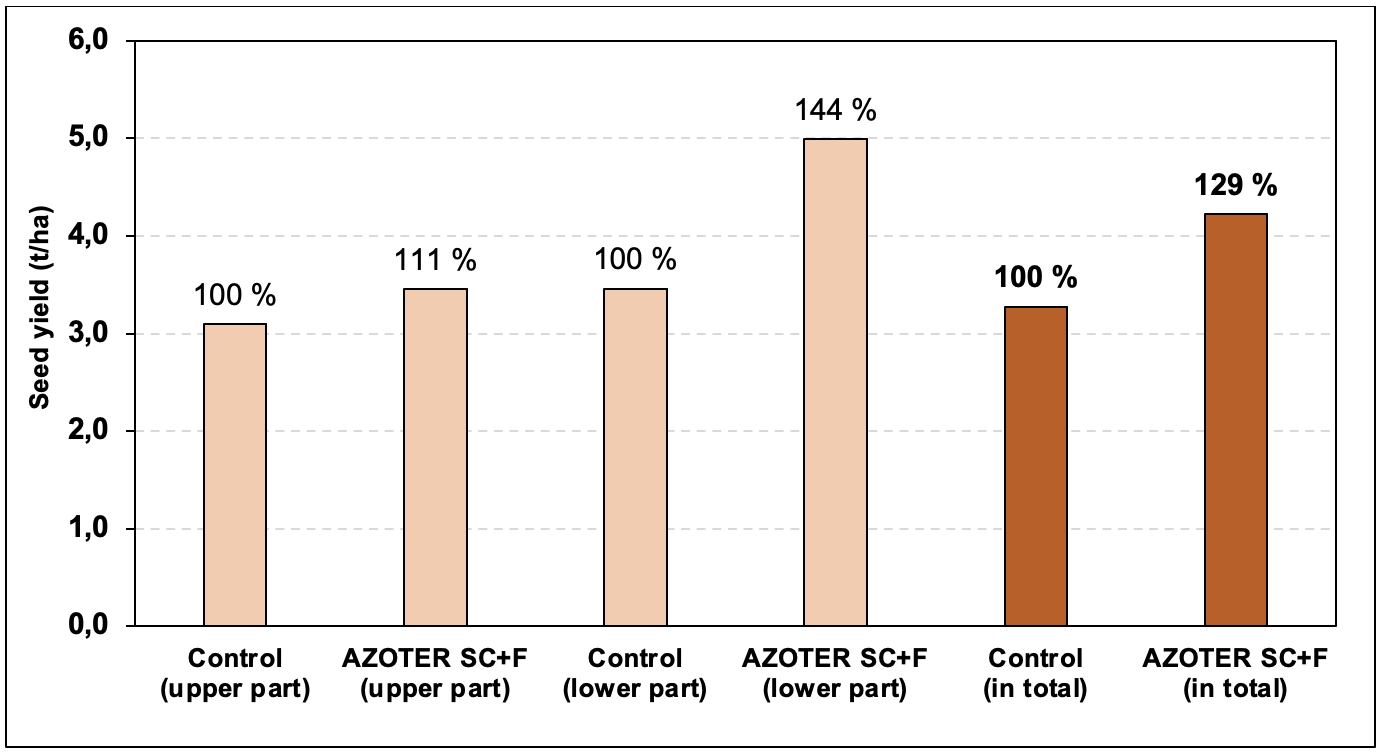
Pic. 5. Achieved yield of rape seed after pre-sowing soil treatment with the tested preparation (harvesting with the threshing machine, on 01/08/2022)
The structure analysis of the achieved yield of rapeseed proves the main elements of an increased yield after treating the soil with a biological preparation before sowing. The tested product had a positive effect on yield partly during the intensive growth and branching, and partly at the very end of seed formation. In experiment 1 and experiment 2, thousand seed weight (TKW) was significantly higher after treating the soil with the preparation. That proved good health of the stands is (especially the main stems), sufficient moisture, nitrogen, and other nutrients in the soil, which could be used up to period of the commencement of their natural ripening. On average, thousand seed weight, documenting the actual seed size, was increased by 22% compared to the untreated control. The discovered weight of the straw proved that the rapeseed plants in the harvest period were fully grown in the above-ground biomass after the pre-sowing soil treatment with the tested preparation. An increased number of main branches (by 1-3 pcs) on the main stems of the plants was observed. The seed weight from the harvested plant samples documents the trend of the achieved increase in seed yield after treating the soil with the tested product. It was more accurately detected from the total harvesting of the experimental plots with the threshing machine. Between the control variants and the pre-sowing soil treatment with the tested biological preparation, the seed quality in oil content was very close. All stands showed higher oiliness (more than 40%) (Table 3).
| Experiment | Variant | Weight (g/m2) | TKW | Oiliness | |
| Straw | Seed | g | % | ||
| Upper part (1) | Control | 1254 | 666 | 4,0 | 41,4 |
| Azoter SC + F | 1465 | 775 | 5,0 | 42,3 | |
| Lower part (2) | Control | 959 | 561 | 3,4 | 43,9 |
| Azoter SC + F | 1443 | 637 | 4,0 | 42,1 | |
| Total | Control | 1107 | 614 | 3,7 | 42,6 |
| Azoter SC + F | 1454 | 706 | 4,5 | 42,2 | |
Tab. 3. Structure of rapeseed yield formation in stands without and with pre-sowing soil treatment with the tested product (before harvest, 20/07/2022).
Conclusions
Agrotechnology of difficult winter rape crop can be purposefully innovated with the biological principles of plant nutrition. The targeted application of natural vital bacteria and fungi in the tested Azoter SC+F fertilizer before sowing made phosphorus deficiency in the soil available despite a very low pH value of soil. After its application, plants nutritional status was improved with phosphorus and nitrogen. In the second half of the vegetation, it was partly improved with potassium. In addition to the effect on the cultivated crop, it was found that the content of calcium and partially potassium and magnesium in the soil improved nutrient availability for the subsequent crop. The selected parasitic fungi in the fertilizer reduced the intensity of the strong fungal infestation of the stands that cause significant losses in seed yield due to ripening process, known in cruciferous vegetables (especially in winter rape).
The purposefully applied set of microbes in the soil used mainly carbonaceous organic matter (sugar compounds) as an energy source. The soil organic carbon content was slightly reduced in the year when the treated crop was grown. A slight decrease in soil organic carbon content can be recovered by more than 30% higher production of straw, which is usually kept on the plot. Treated plants also showed greater production of root biomass. The content of organic nitrogen as a stable nitrogen supply in the soil was not fundamentally affected by the application of the fertilizer, which means that it was not a significant source of energy for microbes. The evaluation of organic substances in the system of winter rape cultivation using Azoter SC+F biological fertilizer can be considered as balanced. The application of the fertilizer contributed to the increase of soil reaction (pH) in acidic soil.
The complex effect that improves the biological fertilizer on the soil, the vegetative and nutritional status of plants and the health status of stands showed an effective increase in seed yield in agrochemical deficient soils with phytopathogenic load.
Recommendation: 1) For optimal effect of applying Azoter SC+F biological fertilizer, it is efficient to apply organic fertilization (preferably manure or compost) or at least keep the straw of the pre-crop (preferably in combination with the application of a smaller dose of manure or digestate) on the plot.
2) For an optimal effect, it is necessary to incorporate the fertilizer into the soil immediately, especially in sunny and windy weather. Pre-sowing preparation is suitable, even a few days (weeks) before sowing.
Economic evaluation: The use of AZOTER SC+F biological fertilizer in the recommended dose of 10 l/ha + separate additives F in the dose of 0.1 l/ha showed a complex effect on the vegetation. The fertilizer supported the nutrition of plants with phosphorus deficiency and the necessary nitrogen. It improved the dynamics of above-ground biomass growth, strengthened the health status of plants, and supported the natural gradual ripening of winter rape stands in deficient soils with phytopathogenic load.
Special pre-sowing treatment of the soil with the tested product using a field sprayer completely covered the additional costs incurred, and it significantly increased the profitability of winter rape cultivation technology:
| Calculation (abbreviated) | Untreated
*control* |
Treated
*Azoter SC + F* |
||
| Experiment 1 | Experiment 2 | Experiment 1 | Experiment 2 | |
| Market performance | ||||
| Seed yield (t/ha) | 3,10 | 3,46 | 3,45 | 4,99 |
| Valuation (CZK/t) | 14 000 | 14 000 | 14 000 | 14 000 |
| Sales (CZK/ha) | 43 400 | 48 440 | 48 300 | 69 860 |
| Variable costs (multiple costs of agricultural machinery) | ||||
| Azoter SC + F (CZK/ha) | 0 | 0 | 1 000 | 1 000 |
| Application (300 l of water/ha) (CZK/ha) | 0 | 0 | 400 | 400 |
| Total (CZK/ha) | 0 | 0 | 1 400 | 1 400 |
| Contribution to cover other costs (Variable costs + Fixed costs ) | ||||
| Contribution (CZK/ha) | 43 400 | 48 440 | 46 900 | 68 460 |
| Contribution difference (CZK/ha) | x | x | 3 500 | 20 020 |
Note: Experiment 1 = represents worse soil conditions, habitat with more intense air flow (NW – W exposure) and with a lower proportion of plants heavily attacked by stem rot
Experiment 2 = represents better soil conditions, a warmer habitat with less air flow (SW-W exposure) and with a higher proportion of plants heavily attacked by stem rot
_______________________
The results of the tested Azoter SC+F biological fertilizer were obtained in 2022, from the established operational experiment in the implemented agricultural company, for AZOTER CZ s.r.o. The results of the experiment were provided to the representatives of the implementing company.
In Žamberk on 12.10.2022
Photo documentation
A,Winter rape stands at the beginning of long-lasting growth on 12/04/2022
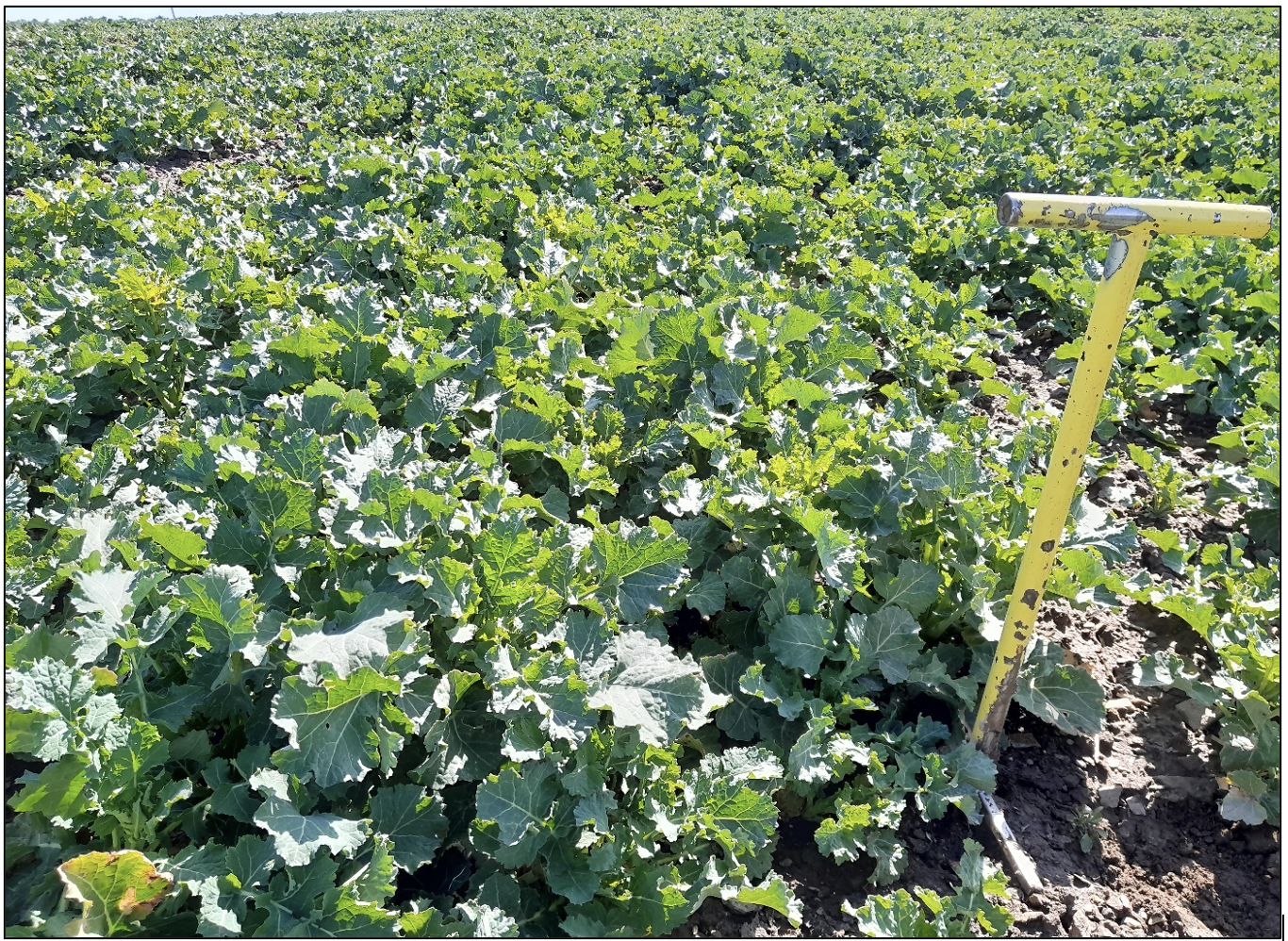
Rapeseed crop in the soil treated with Azoter SC+F biological fertilizer before sowing
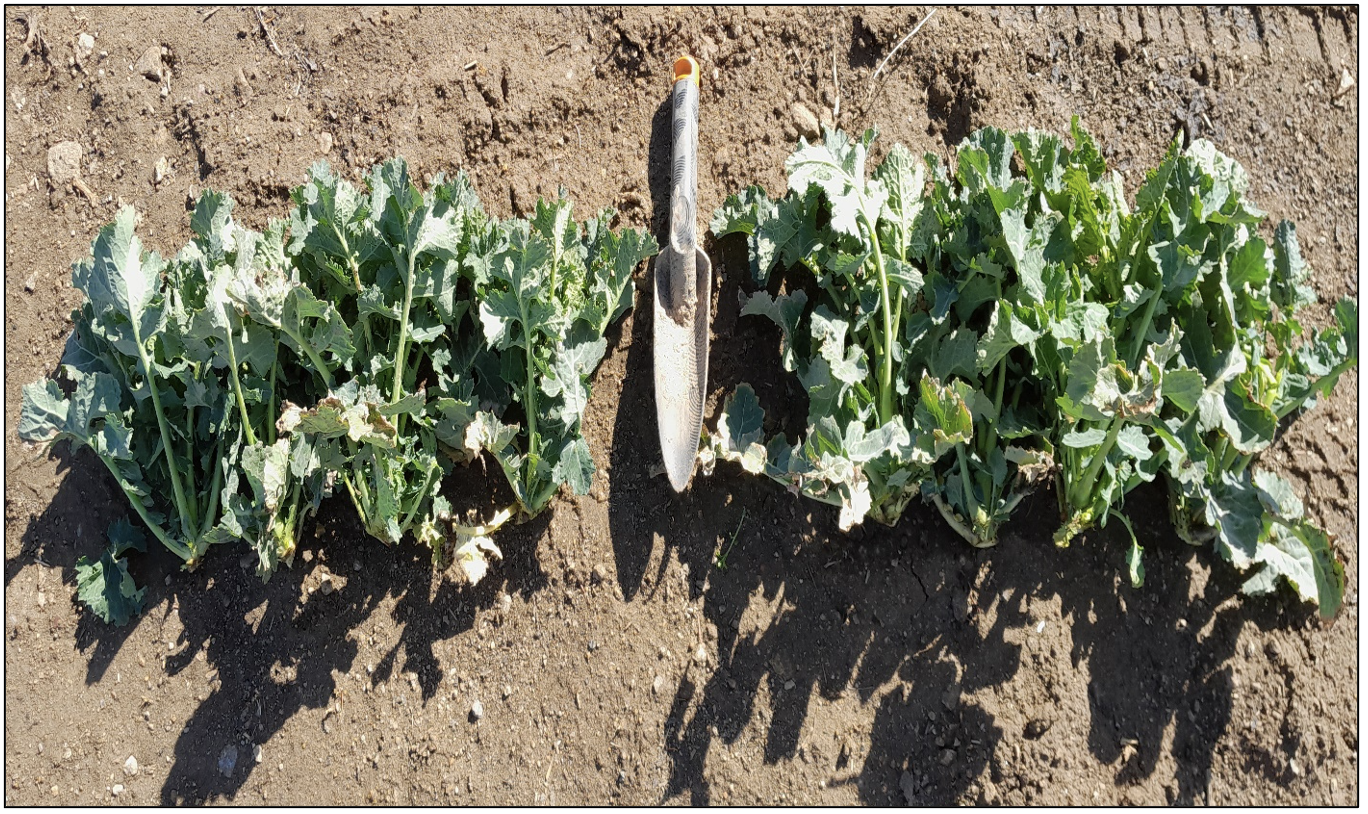
B,Winter rape stands at the time of flowering on 19/05/2022
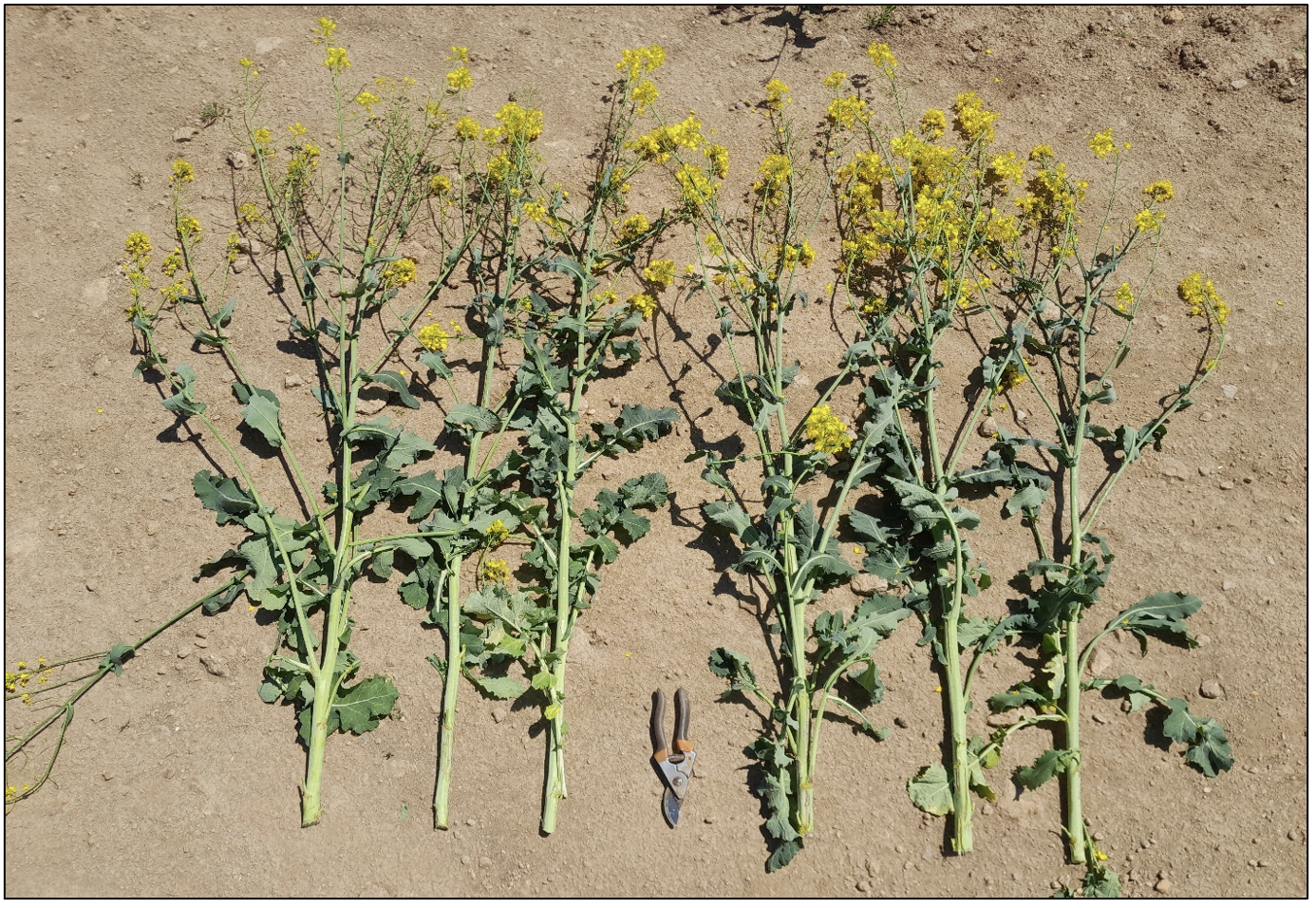
Control Azoter SC + F
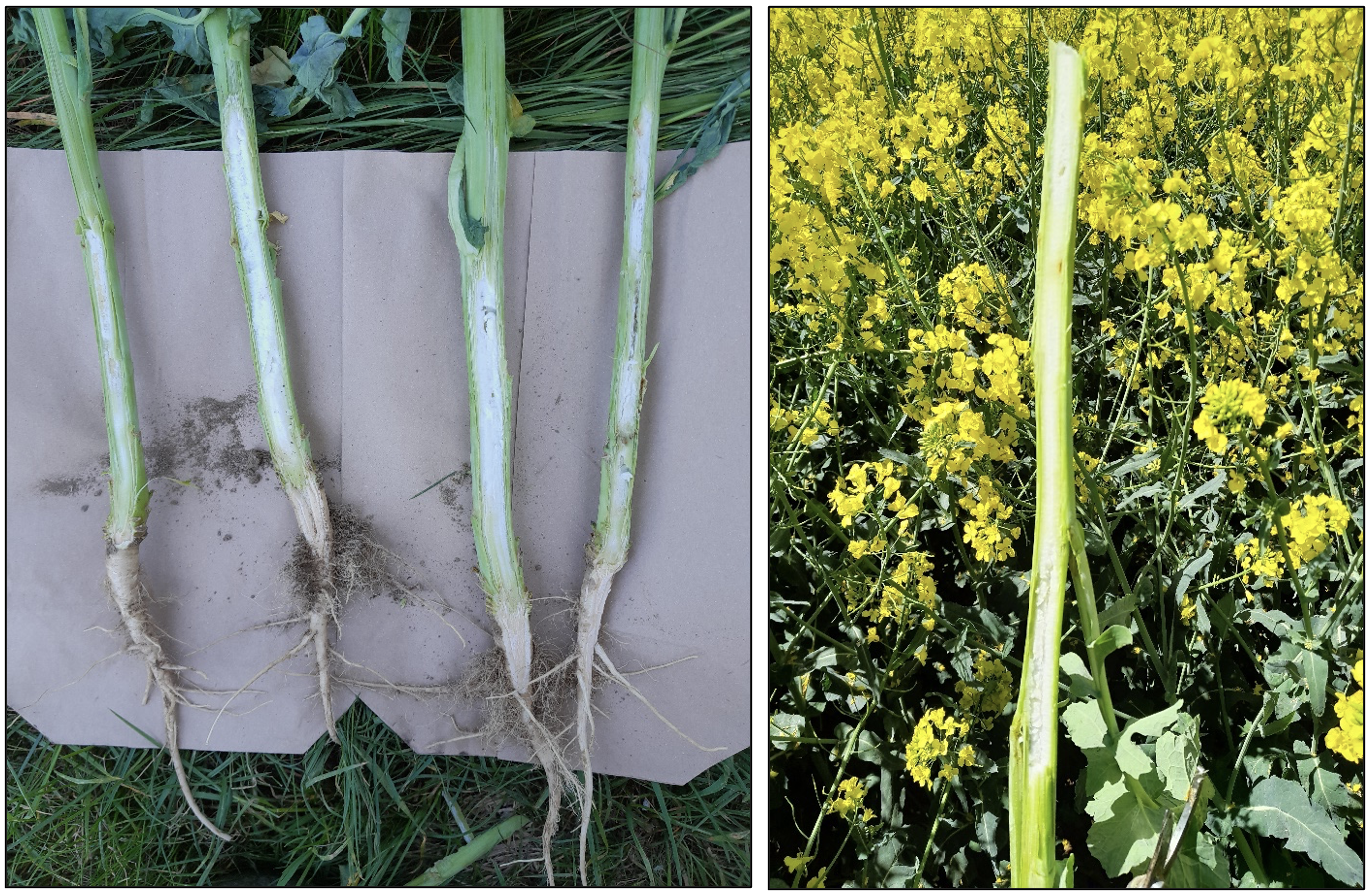
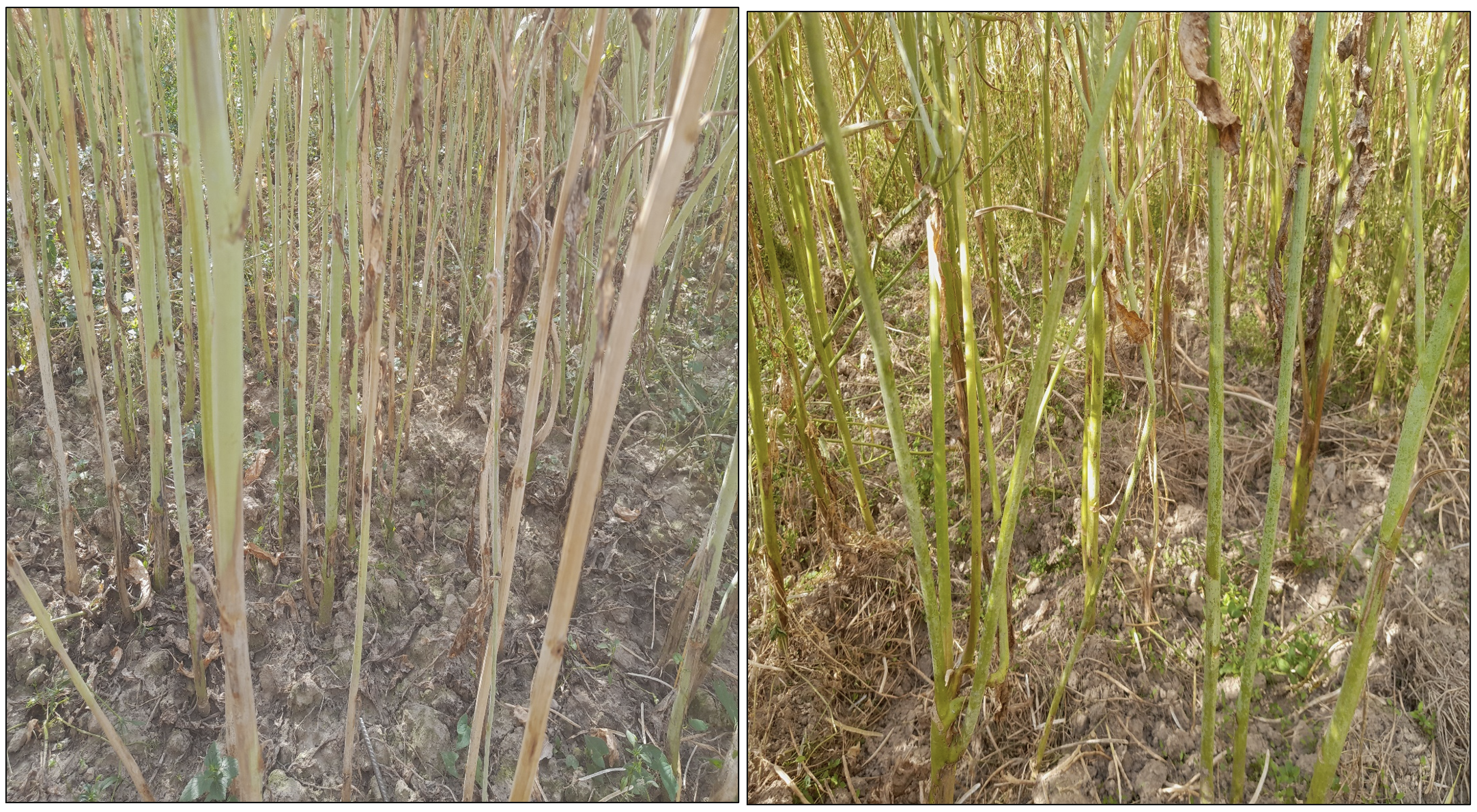
Control (higher proportion of stems heavily attacked by rot) / Azoter SC + F (lower proportion of severe infestation and higher proportion of healthy plants)
